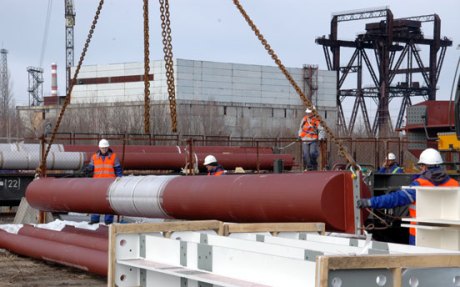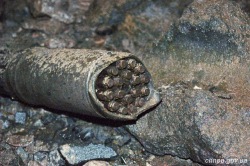The first batch of steel has arrived at Chernobyl for the giant arched structure that will protect the ruined power plant and enable its dismantling. Assembly of the arch is set to begin next month.
 |
| Sections of steel tubing that have an important role ahead of them |
The 149 tonne consignment received at the site will go towards the central segment of an arch some 108 metres high that will extend for 257 metres over the plant buildings. Supplied from Italy, the first batch arrived by rail; the second, which makes up some 1030 tonnes, will follow by sea and road. In total some 20,000 tonnes of steel will be required for the Chernobyl New Safe Confinement (NSC) project.
The structure will be assembled on concrete rails and slid into place over the broken buildings of Chernobyl 4, which was destroyed by the steam and hydrogen explosions that followed a power excursion in April 1986. Once hermetically sealed, it will allow engineers to remotely dismantle the hastily constructed 'sarcophagus' that has shielded the remains of the reactor from the weather since the weeks after the accident. The stability of the sarcophagus has developed into one of the major risk factors at the site, and its potential collapse threatens to liberate more radioactive materials. A project to shore up the structure was completed in mid-2008 but the NSC would reduce the consequences of a collapse while also allowing the sarcophagus to be taken apart under controlled conditions.
 |
| What lies within: A highly radioactive and severely damaged fuel assembly within the reactor building |
Other objectives for the structure are to generally reduce emissions from the buildings for a design-life of 100 years while at the same time stopping the ingress of water, which increases the risk that nuclear fuels scattered inside the building could potentially see sustained fission reactions. The huge building is meant to enable the eventual removal of materials containing nuclear fuel and accommodate their characterisation, compaction and packing for disposal. This task represents the most important step in eliminating nuclear hazard at the site - and the real start of decommissioning. The NSC will facilitate remote handling of these dangerous materials, using as few personnel as possible.
Assembly work for the NSC structure is planned to start in April and it is slated to be in place sometime in 2015.
The environmental restoration work at Chernobyl is funded by 29 donor countries to the Chernobyl Shelter Fund, set up in 1997, which is administered by the European Bank for Reconstruction and Development. The necessary funds for the project were secured in July last year.
Researched and written
by World Nuclear News





_18570.jpg)
_16159.jpg)
_18938.jpg)
_33584.jpg)





